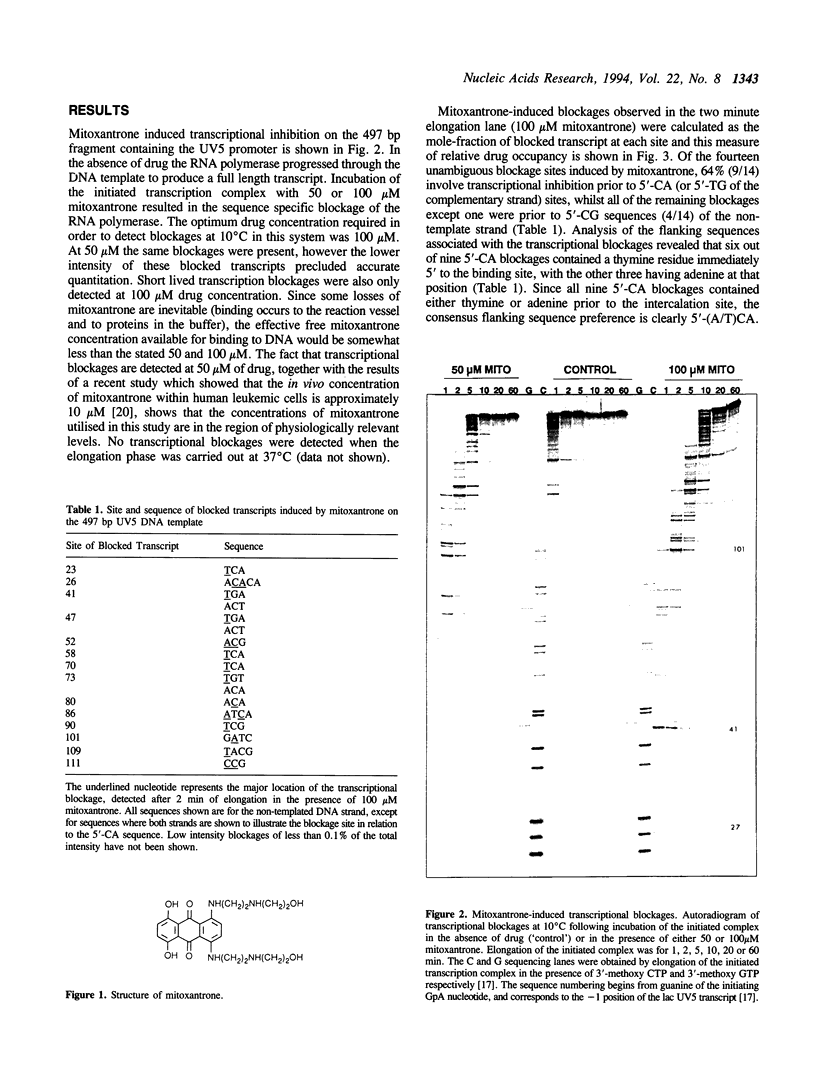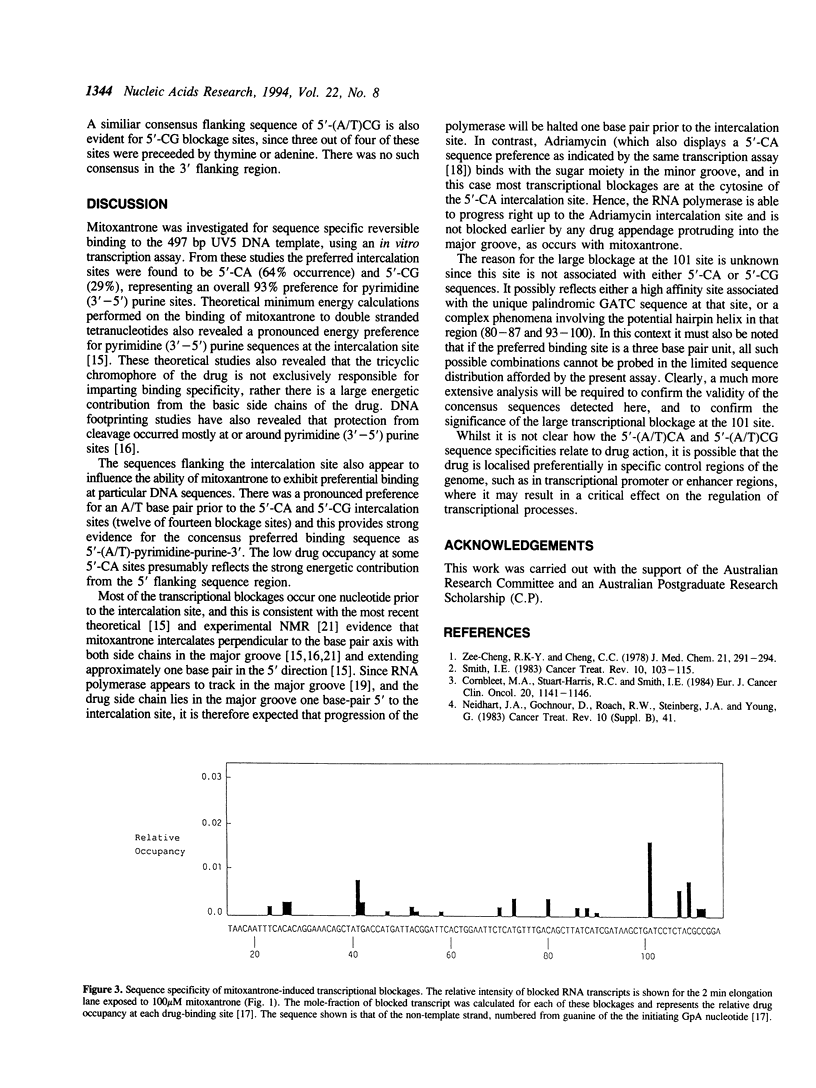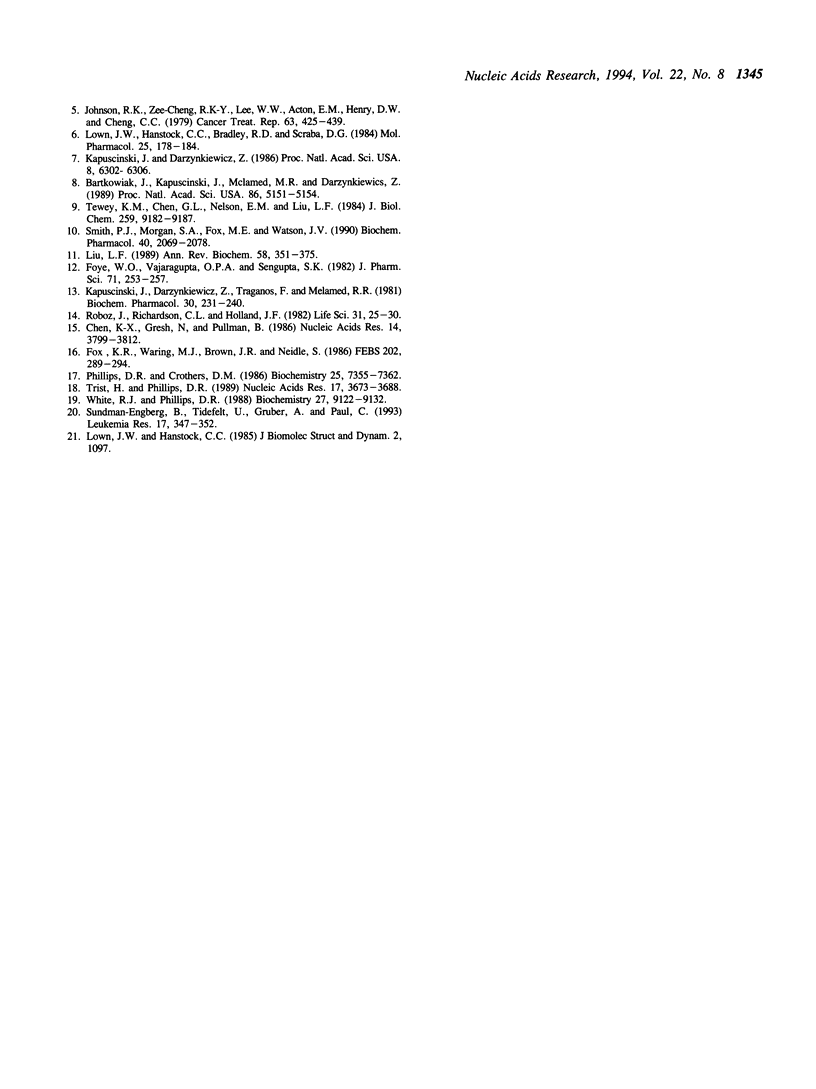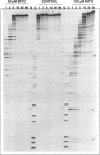Abstract
An in vitro transcription assay was used to determine the sequence specificity of binding of mitoxantrone to a 497 bp fragment of DNA containing the lac UV5 promoter. Transcriptional blockages of the E. coli RNA polymerase were observed dominantly prior to 5'-CpA sequences (64% occurrence), and to a lesser extent 5'-CpG sequences (29%). Overall, 93% of all blockage sites were prior to pyrimidine (3'-5') purine sequences. An effect of flanking sequences was evident since the blockage sites contained an A/T base pair 5' prior to the consensus CpA and CpG intercalation sites. The consensus sequences for the preferred mitoxantrone intercalation sites are therefore 5'-(A/T)CA and 5'-(A/T)CG. The location of transcriptional blockages one base pair prior to the intercalation site is consistent with the fact that the mitoxantrone side chains lie in the major groove.
Full text
PDF



Images in this article
Selected References
These references are in PubMed. This may not be the complete list of references from this article.
- Bartkowiak J., Kapuscinski J., Melamed M. R., Darzynkiewicz Z. Selective displacement of nuclear proteins by antitumor drugs having affinity for nucleic acids. Proc Natl Acad Sci U S A. 1989 Jul;86(13):5151–5154. doi: 10.1073/pnas.86.13.5151. [DOI] [PMC free article] [PubMed] [Google Scholar]
- Chen K. X., Gresh N., Pullman B. A theoretical investigation on the sequence selective binding of mitoxantrone to double-stranded tetranucleotides. Nucleic Acids Res. 1986 May 12;14(9):3799–3812. doi: 10.1093/nar/14.9.3799. [DOI] [PMC free article] [PubMed] [Google Scholar]
- Cornbleet M. A., Stuart-Harris R. C., Smith I. E., Coleman R. E., Rubens R. D., McDonald M., Mouridsen H. T., Rainer H., van Oosterom A. T., Smyth J. F. Mitoxantrone for the treatment of advanced breast cancer: single-agent therapy in previously untreated patients. Eur J Cancer Clin Oncol. 1984 Sep;20(9):1141–1146. doi: 10.1016/0277-5379(84)90122-6. [DOI] [PubMed] [Google Scholar]
- Fox K. R., Waring M. J., Brown J. R., Neidle S. DNA sequence preferences for the anti-cancer drug mitoxanthrone and related anthraquinones revealed by DNase I footprinting. FEBS Lett. 1986 Jul 7;202(2):289–294. doi: 10.1016/0014-5793(86)80703-7. [DOI] [PubMed] [Google Scholar]
- Foye W. O., Vajragupta O., Sengupta S. K. DNA-binding specificity and RNA polymerase inhibitory activity of bis(aminoalkyl)anthraquinones and bis(methylthio)vinylquinolinium iodides. J Pharm Sci. 1982 Feb;71(2):253–257. doi: 10.1002/jps.2600710228. [DOI] [PubMed] [Google Scholar]
- Johnson R. K., Zee-Cheng R. K., Lee W. W., Acton E. M., Henry D. W., Cheng C. C. Experimental antitumor activity of aminoanthraquinones. Cancer Treat Rep. 1979 Mar;63(3):425–439. [PubMed] [Google Scholar]
- Kapuscinski J., Darzynkiewicz Z. Relationship between the pharmacological activity of antitumor drugs Ametantrone and mitoxantrone (Novatrone) and their ability to condense nucleic acids. Proc Natl Acad Sci U S A. 1986 Sep;83(17):6302–6306. doi: 10.1073/pnas.83.17.6302. [DOI] [PMC free article] [PubMed] [Google Scholar]
- Kapuscinski J., Darzynkiewicz Z., Traganos F., Melamed M. R. Interactions of a new antitumor agent, 1,4-dihydroxy-5,8-bis[[2-[(2-hydroxyethyl)amino]-ethyl]amino]-9,10-anthracenedione, with nucleic acids. Biochem Pharmacol. 1981 Feb 1;30(3):231–240. doi: 10.1016/0006-2952(81)90083-6. [DOI] [PubMed] [Google Scholar]
- Liu L. F. DNA topoisomerase poisons as antitumor drugs. Annu Rev Biochem. 1989;58:351–375. doi: 10.1146/annurev.bi.58.070189.002031. [DOI] [PubMed] [Google Scholar]
- Lown J. W., Hanstock C. C., Bradley R. D., Scraba D. G. Interactions of the antitumor agents mitoxantrone and bisantrene with deoxyribonucleic acids studied by electron microscopy. Mol Pharmacol. 1984 Jan;25(1):178–184. [PubMed] [Google Scholar]
- Lown J. W., Hanstock C. C. High field 1H-NMR analysis of the 1:1 intercalation complex of the antitumor agent mitoxantrone and the DNA duplex [d(CpGpCpG)]. J Biomol Struct Dyn. 1985 Jun;2(6):1097–1106. doi: 10.1080/07391102.1985.10507626. [DOI] [PubMed] [Google Scholar]
- Phillips D. R., Crothers D. M. Kinetics and sequence specificity of drug-DNA interactions: an in vitro transcription assay. Biochemistry. 1986 Nov 18;25(23):7355–7362. doi: 10.1021/bi00371a017. [DOI] [PubMed] [Google Scholar]
- Roboz J., Richardson C. L., Holland J. F. Comparison of the interaction of antineoplastic aminoanthraquinone analogs with DNA using competitive fluorescence polarization. Life Sci. 1982 Jul 5;31(1):25–30. doi: 10.1016/0024-3205(82)90396-4. [DOI] [PubMed] [Google Scholar]
- Smith P. J., Morgan S. A., Fox M. E., Watson J. V. Mitoxantrone-DNA binding and the induction of topoisomerase II associated DNA damage in multi-drug resistant small cell lung cancer cells. Biochem Pharmacol. 1990 Nov 1;40(9):2069–2078. doi: 10.1016/0006-2952(90)90237-f. [DOI] [PubMed] [Google Scholar]
- Sundman-Engberg B., Tidefelt U., Gruber A., Paul C. Intracellular concentrations of mitoxantrone in leukemic cells in vitro vs in vivo. Leuk Res. 1993 Apr;17(4):347–352. doi: 10.1016/0145-2126(93)90022-d. [DOI] [PubMed] [Google Scholar]
- Tewey K. M., Chen G. L., Nelson E. M., Liu L. F. Intercalative antitumor drugs interfere with the breakage-reunion reaction of mammalian DNA topoisomerase II. J Biol Chem. 1984 Jul 25;259(14):9182–9187. [PubMed] [Google Scholar]
- Trist H., Phillips D. R. In vitro transcription analysis of the role of flanking sequence on the DNA sequence specificity of adriamycin. Nucleic Acids Res. 1989 May 25;17(10):3673–3688. doi: 10.1093/nar/17.10.3673. [DOI] [PMC free article] [PubMed] [Google Scholar]
- White R. J., Phillips D. R. Transcriptional analysis of multisite drug-DNA dissociation kinetics: delayed termination of transcription by actinomycin D. Biochemistry. 1988 Dec 27;27(26):9122–9132. doi: 10.1021/bi00426a009. [DOI] [PubMed] [Google Scholar]
- Zee-Cheng R. K., Cheng C. C. Antineoplastic agents. Structure-activity relationship study of bis(substituted aminoalkylamino)anthraquinones. J Med Chem. 1978 Mar;21(3):291–294. doi: 10.1021/jm00201a012. [DOI] [PubMed] [Google Scholar]



